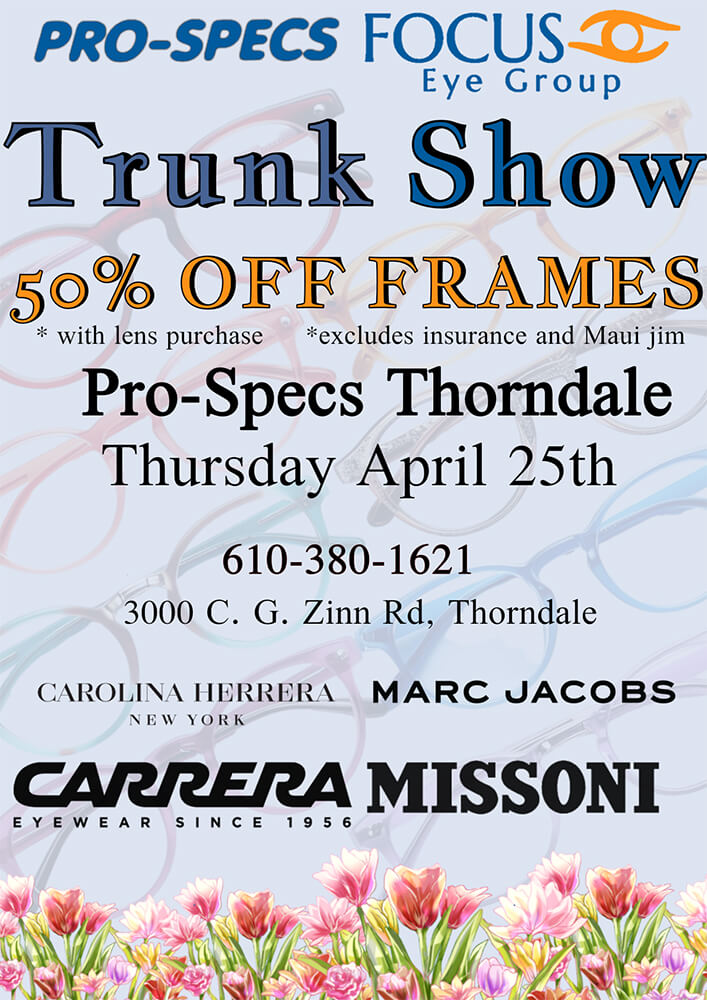Lets Talk About Age-Related Macular Degeneration
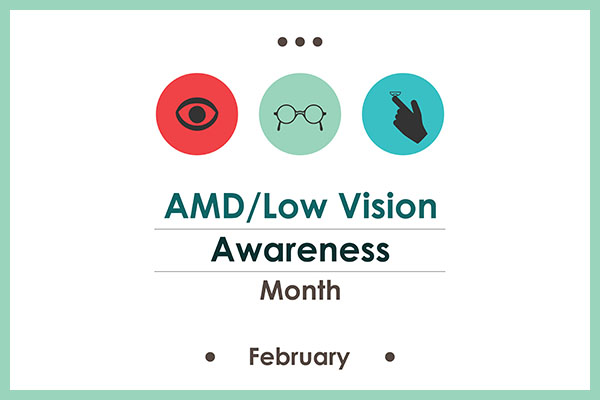
It’s February, a month known for being gray, dreary, and unpredictable in Berwyn. But besides that, did you know February is Age-Related Macular Degeneration Awareness month?
It sounds like a bit of a mouthful, but it’s important when it comes to your eye health. Not sure if you’re aware about AMD? Keep reading to learn more about this eye condition!
What is AMD?
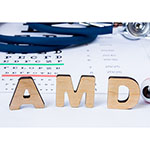
Age-related macular degeneration is a leading cause of vision loss for people over 50. This makes it an extremely common eye condition.
AMD occurs when the macula, which is part of the retina, becomes damaged.
With AMD, arteries that should sustain the macula instead start hardening. When this happens, retinal tissues start to weaken and eventually die.
When retinal tissues die, it leads to vision loss. The macula handles keeping our central vision sharp and accurate.
With AMD, vision loss may only start with peripheral vision, since it does not lead to total blindness right away.
There are two kinds of AMD: wet and dry. The more common kind is dry AMD.
In wet AMD or neovascular AMD, the eye tries to make up for dead retinal tissues and the now blocked arteries. New blood vessels grow in the retina, but they are not as strong as the old retinal tissues.
As a result, the blood vessels often leak fluids and blood in the layers of the retina. When leaking occurs, vision becomes distorted.
What’s more, when the fluids and blood dry, they leave scar tissue on the retina. It’s this scar tissue that creates dark spots on your vision.
In dry AMD, (known as non-neovascular) the eye does not create any new leaking blood vessels. Instead, small particles form inside the eye, which are called drusen.
It may take a significant period of time, but with drusen, the retina and macula will deteriorate. Deterioration due to drusen causes vision loss in patients who have dry AMD.
Who is at risk for age-related macular degeneration?
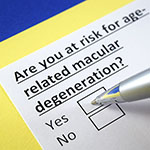
You are at the highest risk for developing AMD if you are 50 or older. But it’s important to realize that you can develop AMD earlier without symptoms.
For some people, AMD can take years to develop. Even while it is developing, it’s often so slow that it’s not noticed until vision loss occurs.
Besides age, many of your lifestyle choices can increase your risk of developing AMD. This includes smoking, high blood pressure, and a sedentary lifestyle.
If you’re a smoker, you should know that smoking doubles your risk of developing age-related macular degeneration.
Like many other eye conditions, you’re also more at risk for developing AMD if you have a family history. This means that you have a relative who has AMD.
If this is the case, you may need comprehensive eye exams on more of a regular basis. Be sure to let your eye doctor know so they can check your eyes periodically.
Are there any symptoms with age-related macular degeneration?
Since age-related macular degeneration develops over time, don’t rely on its symptoms. Most patients only notice any vision loss after AMD has become more advanced.
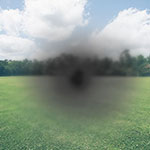
Common symptoms include:
- blurry vision
- a dark spot or area that appears in the middle of your vision
- loss of color vision over time
- less able to see objects clearly over time
Some of these symptoms are the same as other eye conditions. If you notice any of them, contact your eye doctor. Even if you have another eye conditions that’s not AMD, you should find out as soon as possible.
A comprehensive eye exam will reveal if you have AMD or not. If you don’t, your eye doctor can keep an eye on any vision changes.
You’re always better off getting checked out. Catching AMD early minimizes your risk of losing a significant amount of your vision!
Preventing AMD
Unlike cataracts, AMD is not something everyone gets. There is no way to guarantee you won’t get AMD, but there are ways to reduce your risks of developing it.
Concerned about developing age-related macular degeneration? Don’t smoke! If you’re a smoker, quit.
Studies show that smoking almost doubles your chances of developing AMD. This is one of the highest risk factors when it comes to developing AMD that you can do something about.
Eating a healthy diet is important, but if you are trying to avoid age-related macular degeneration, make sure you’re eating leafy greens.
These include vegetables like kale, raw spinach, and swiss chard. Leafy green vegetables contain carotenoids, which are high in antioxidants.
If you are overweight or have high cholesterol, you are also at a higher risk of developing AMD. Staying active and exercising regularly can make a big difference when it comes to not developing age-related macular degeneration!
This is true not just for your health, but your eyes as well. People that are a healthy weight and stay active are less likely to develop AMD. This is not to say it’s impossible, but it’s a good idea to stay healthy, inside and out!
Treating age-related macular degeneration
If you receive an AMD diagnosis, it’s not the end of the world. Like other eye conditions, it’s always better to diagnose and treat AMD at the earliest stage possible.
For patients with dry AMD, there is no treatment. Your eye doctor may prescribe Vitamins E, C, copper, lutein, zinc, and zeaxanthin. In large studies, these vitamins and minerals have shown that they can help slow down advancing AMD.
If you have large amounts of drusen or you’ve lost a lot of vision, vitamins and minerals may be most beneficial to you. Before starting any new supplements, talk with your eye doctor about their recommendations. These are not guaranteed to work on every patient.
Slowing down dry AMD is key because dry AMD can advance to wet AMD over time. With wet AMD, there are treatment options available.
If you have wet AMD, your eye doctor may recommend trying anti-VEGF treatments. VEGF stands for vascular endothelial growth factor.
VEGF is a protein produced by cells in the body. When the body needs them, VEGF creates new blood vessels. This is a good thing unless the body starts producing abnormal blood vessels in the eye.
These abnormal blood vessels are what leads to wet AMD. Anti-VEGF treatments slow down the growth of abnormal blood vessels.
They also help prevent the formation of any new abnormal blood vessels in the eye and stop leaking. Anti-VEGF treatments are administered after numbing the eye. Once the eye becomes numb, the medication is then injected into the white of the eye.
Injection takes just a few seconds. Depending on AMD severity, you may need several treatments to achieve visual stabilization.
Your eye doctor will determine this depending on results from your anti-VEGF treatment. The most common anti-VEGF treatments are medications called Avastin and Lucentis.
Another way of treating wet AMD is with laser treatment. During this treatment, your eye doctor will shine a laser beam on the abnormal blood vessels.
The laser helps reduce the amount of blood vessels, and slows down any leaking. Laser treatment may be recommended if anti-VEGF treatments aren’t helping to decrease blood vessel growth.
When caught in its earliest stages, age-related macular degeneration can stay controlled and maintained. This is why it’s so important to see your eye doctor on a regular basis for comprehensive eye exams. It is only at these eye exams that age-related macular degeneration will be detected.
Looking for more information about age-related macular degeneration awareness? Schedule a consultation with the Eye Doctors of Chester County in Berwyn, PA today!





